Case Study: Social Determinants Impact on Cardiovascular Health
VerifiedAdded on 2023/01/13
|6
|1305
|71
Case Study
AI Summary
This case study investigates the social determinants of cardiovascular health in Australia, highlighting the significant impact of factors such as unemployment, food access, healthcare availability, and education on cardiovascular disease incidence. The study emphasizes that lower socioeconomic groups, including Aboriginal and Torres Strait Islander populations, experience disproportionately higher rates of mortality and hospitalization due to cardiovascular disease. It explores how these social determinants influence lifestyle choices, access to healthcare, and overall health outcomes, with a focus on the role of community health nurses in addressing these issues. The case study references various sources to support its findings and underscores the importance of upstream thinking and strategic actions to mitigate the effects of environmental health problems. The assignment provides a comprehensive analysis of how social factors affect health and provides insights into the issue.
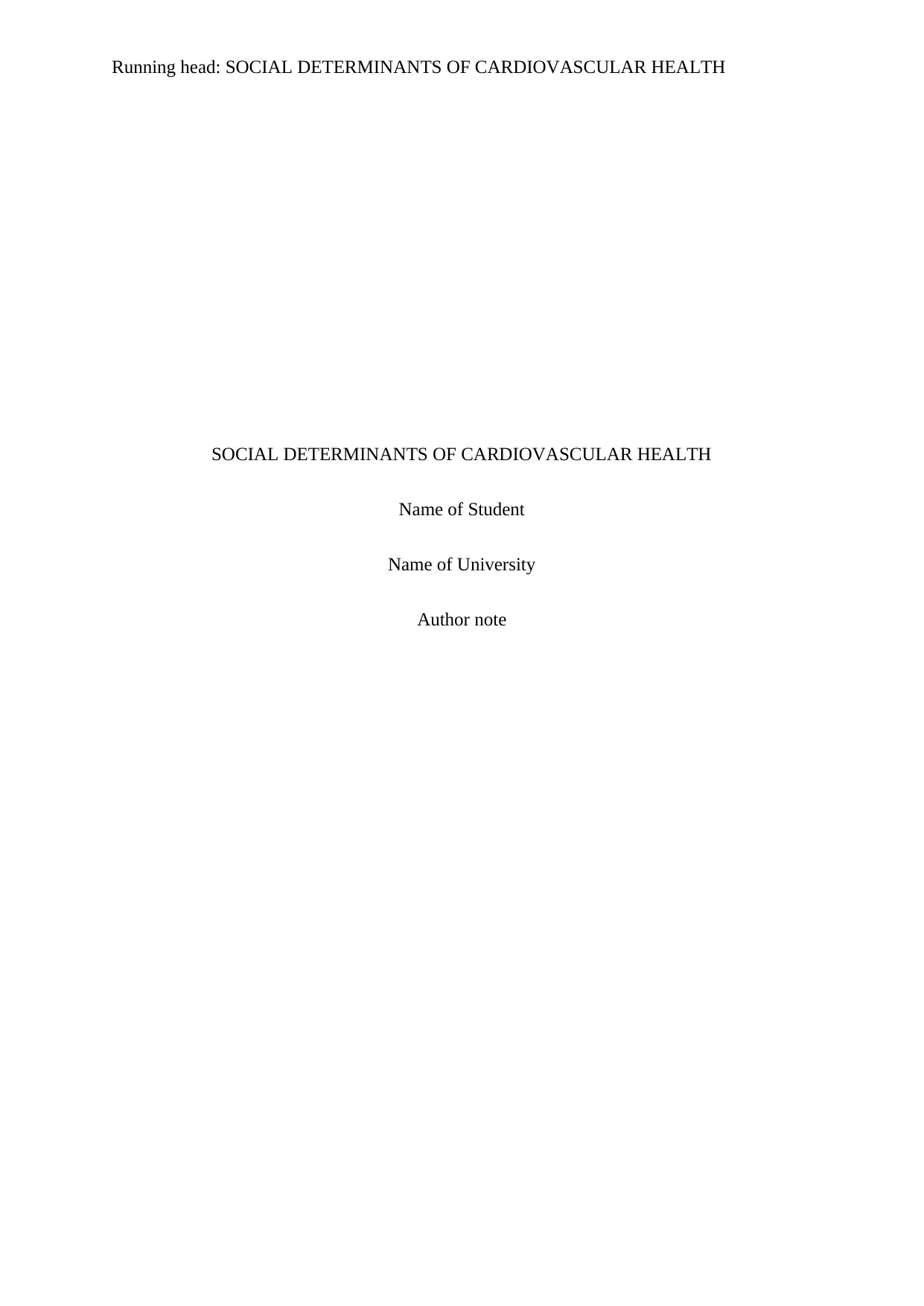
Running head: SOCIAL DETERMINANTS OF CARDIOVASCULAR HEALTH
SOCIAL DETERMINANTS OF CARDIOVASCULAR HEALTH
Name of Student
Name of University
Author note
SOCIAL DETERMINANTS OF CARDIOVASCULAR HEALTH
Name of Student
Name of University
Author note
Paraphrase This Document
Need a fresh take? Get an instant paraphrase of this document with our AI Paraphraser
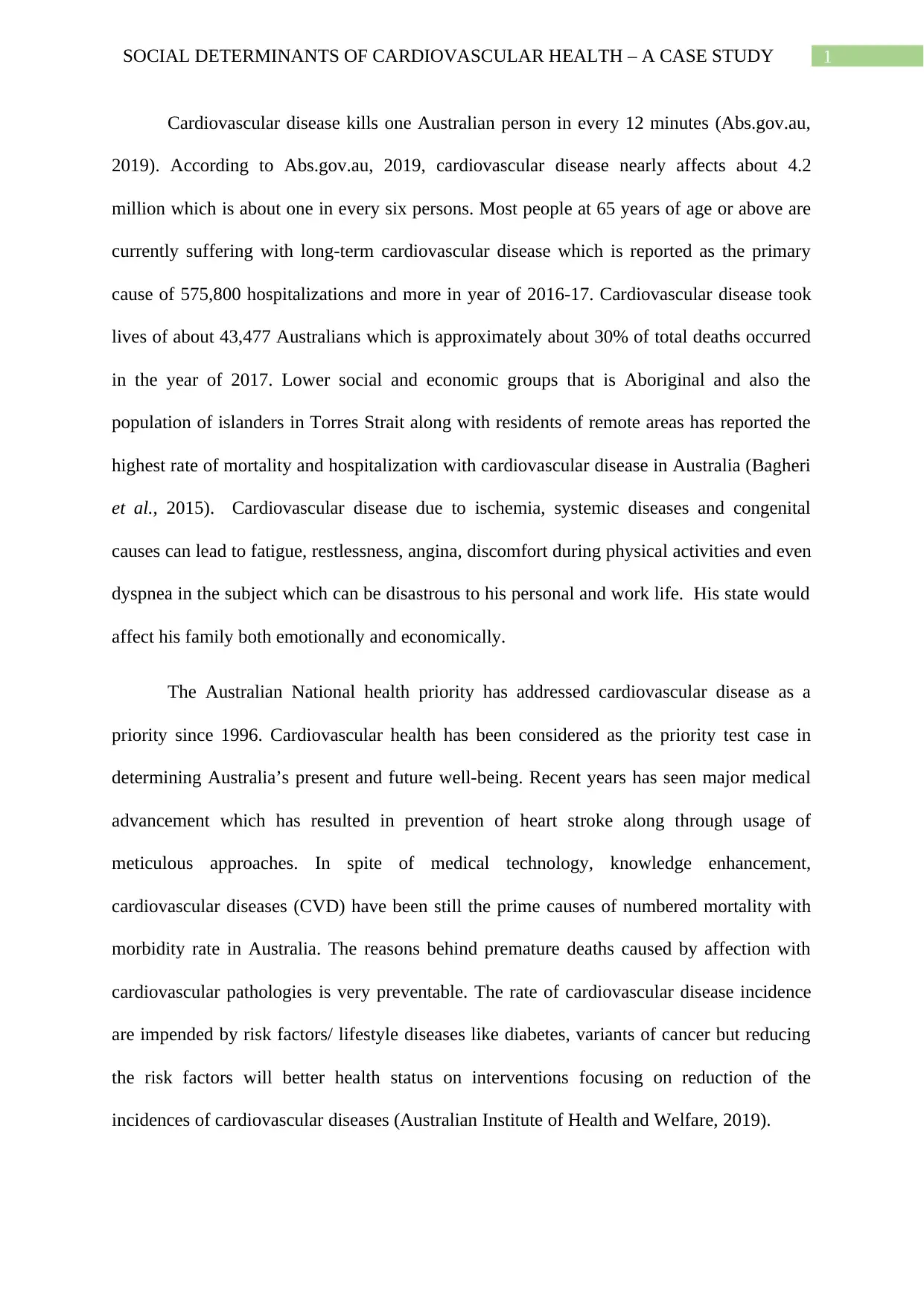
1SOCIAL DETERMINANTS OF CARDIOVASCULAR HEALTH – A CASE STUDY
Cardiovascular disease kills one Australian person in every 12 minutes (Abs.gov.au,
2019). According to Abs.gov.au, 2019, cardiovascular disease nearly affects about 4.2
million which is about one in every six persons. Most people at 65 years of age or above are
currently suffering with long-term cardiovascular disease which is reported as the primary
cause of 575,800 hospitalizations and more in year of 2016-17. Cardiovascular disease took
lives of about 43,477 Australians which is approximately about 30% of total deaths occurred
in the year of 2017. Lower social and economic groups that is Aboriginal and also the
population of islanders in Torres Strait along with residents of remote areas has reported the
highest rate of mortality and hospitalization with cardiovascular disease in Australia (Bagheri
et al., 2015). Cardiovascular disease due to ischemia, systemic diseases and congenital
causes can lead to fatigue, restlessness, angina, discomfort during physical activities and even
dyspnea in the subject which can be disastrous to his personal and work life. His state would
affect his family both emotionally and economically.
The Australian National health priority has addressed cardiovascular disease as a
priority since 1996. Cardiovascular health has been considered as the priority test case in
determining Australia’s present and future well-being. Recent years has seen major medical
advancement which has resulted in prevention of heart stroke along through usage of
meticulous approaches. In spite of medical technology, knowledge enhancement,
cardiovascular diseases (CVD) have been still the prime causes of numbered mortality with
morbidity rate in Australia. The reasons behind premature deaths caused by affection with
cardiovascular pathologies is very preventable. The rate of cardiovascular disease incidence
are impended by risk factors/ lifestyle diseases like diabetes, variants of cancer but reducing
the risk factors will better health status on interventions focusing on reduction of the
incidences of cardiovascular diseases (Australian Institute of Health and Welfare, 2019).
Cardiovascular disease kills one Australian person in every 12 minutes (Abs.gov.au,
2019). According to Abs.gov.au, 2019, cardiovascular disease nearly affects about 4.2
million which is about one in every six persons. Most people at 65 years of age or above are
currently suffering with long-term cardiovascular disease which is reported as the primary
cause of 575,800 hospitalizations and more in year of 2016-17. Cardiovascular disease took
lives of about 43,477 Australians which is approximately about 30% of total deaths occurred
in the year of 2017. Lower social and economic groups that is Aboriginal and also the
population of islanders in Torres Strait along with residents of remote areas has reported the
highest rate of mortality and hospitalization with cardiovascular disease in Australia (Bagheri
et al., 2015). Cardiovascular disease due to ischemia, systemic diseases and congenital
causes can lead to fatigue, restlessness, angina, discomfort during physical activities and even
dyspnea in the subject which can be disastrous to his personal and work life. His state would
affect his family both emotionally and economically.
The Australian National health priority has addressed cardiovascular disease as a
priority since 1996. Cardiovascular health has been considered as the priority test case in
determining Australia’s present and future well-being. Recent years has seen major medical
advancement which has resulted in prevention of heart stroke along through usage of
meticulous approaches. In spite of medical technology, knowledge enhancement,
cardiovascular diseases (CVD) have been still the prime causes of numbered mortality with
morbidity rate in Australia. The reasons behind premature deaths caused by affection with
cardiovascular pathologies is very preventable. The rate of cardiovascular disease incidence
are impended by risk factors/ lifestyle diseases like diabetes, variants of cancer but reducing
the risk factors will better health status on interventions focusing on reduction of the
incidences of cardiovascular diseases (Australian Institute of Health and Welfare, 2019).
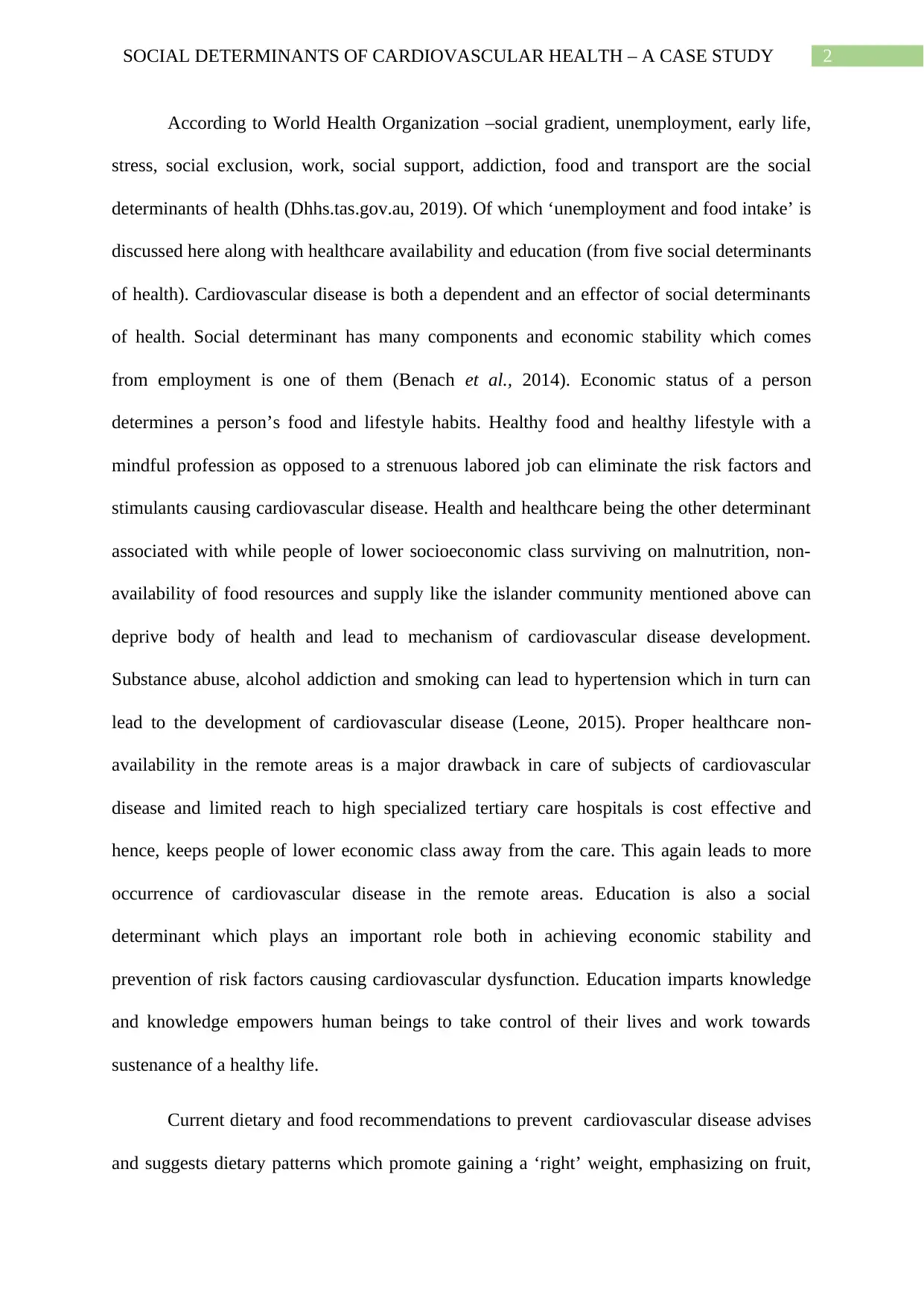
2SOCIAL DETERMINANTS OF CARDIOVASCULAR HEALTH – A CASE STUDY
According to World Health Organization –social gradient, unemployment, early life,
stress, social exclusion, work, social support, addiction, food and transport are the social
determinants of health (Dhhs.tas.gov.au, 2019). Of which ‘unemployment and food intake’ is
discussed here along with healthcare availability and education (from five social determinants
of health). Cardiovascular disease is both a dependent and an effector of social determinants
of health. Social determinant has many components and economic stability which comes
from employment is one of them (Benach et al., 2014). Economic status of a person
determines a person’s food and lifestyle habits. Healthy food and healthy lifestyle with a
mindful profession as opposed to a strenuous labored job can eliminate the risk factors and
stimulants causing cardiovascular disease. Health and healthcare being the other determinant
associated with while people of lower socioeconomic class surviving on malnutrition, non-
availability of food resources and supply like the islander community mentioned above can
deprive body of health and lead to mechanism of cardiovascular disease development.
Substance abuse, alcohol addiction and smoking can lead to hypertension which in turn can
lead to the development of cardiovascular disease (Leone, 2015). Proper healthcare non-
availability in the remote areas is a major drawback in care of subjects of cardiovascular
disease and limited reach to high specialized tertiary care hospitals is cost effective and
hence, keeps people of lower economic class away from the care. This again leads to more
occurrence of cardiovascular disease in the remote areas. Education is also a social
determinant which plays an important role both in achieving economic stability and
prevention of risk factors causing cardiovascular dysfunction. Education imparts knowledge
and knowledge empowers human beings to take control of their lives and work towards
sustenance of a healthy life.
Current dietary and food recommendations to prevent cardiovascular disease advises
and suggests dietary patterns which promote gaining a ‘right’ weight, emphasizing on fruit,
According to World Health Organization –social gradient, unemployment, early life,
stress, social exclusion, work, social support, addiction, food and transport are the social
determinants of health (Dhhs.tas.gov.au, 2019). Of which ‘unemployment and food intake’ is
discussed here along with healthcare availability and education (from five social determinants
of health). Cardiovascular disease is both a dependent and an effector of social determinants
of health. Social determinant has many components and economic stability which comes
from employment is one of them (Benach et al., 2014). Economic status of a person
determines a person’s food and lifestyle habits. Healthy food and healthy lifestyle with a
mindful profession as opposed to a strenuous labored job can eliminate the risk factors and
stimulants causing cardiovascular disease. Health and healthcare being the other determinant
associated with while people of lower socioeconomic class surviving on malnutrition, non-
availability of food resources and supply like the islander community mentioned above can
deprive body of health and lead to mechanism of cardiovascular disease development.
Substance abuse, alcohol addiction and smoking can lead to hypertension which in turn can
lead to the development of cardiovascular disease (Leone, 2015). Proper healthcare non-
availability in the remote areas is a major drawback in care of subjects of cardiovascular
disease and limited reach to high specialized tertiary care hospitals is cost effective and
hence, keeps people of lower economic class away from the care. This again leads to more
occurrence of cardiovascular disease in the remote areas. Education is also a social
determinant which plays an important role both in achieving economic stability and
prevention of risk factors causing cardiovascular dysfunction. Education imparts knowledge
and knowledge empowers human beings to take control of their lives and work towards
sustenance of a healthy life.
Current dietary and food recommendations to prevent cardiovascular disease advises
and suggests dietary patterns which promote gaining a ‘right’ weight, emphasizing on fruit,
⊘ This is a preview!⊘
Do you want full access?
Subscribe today to unlock all pages.

Trusted by 1+ million students worldwide
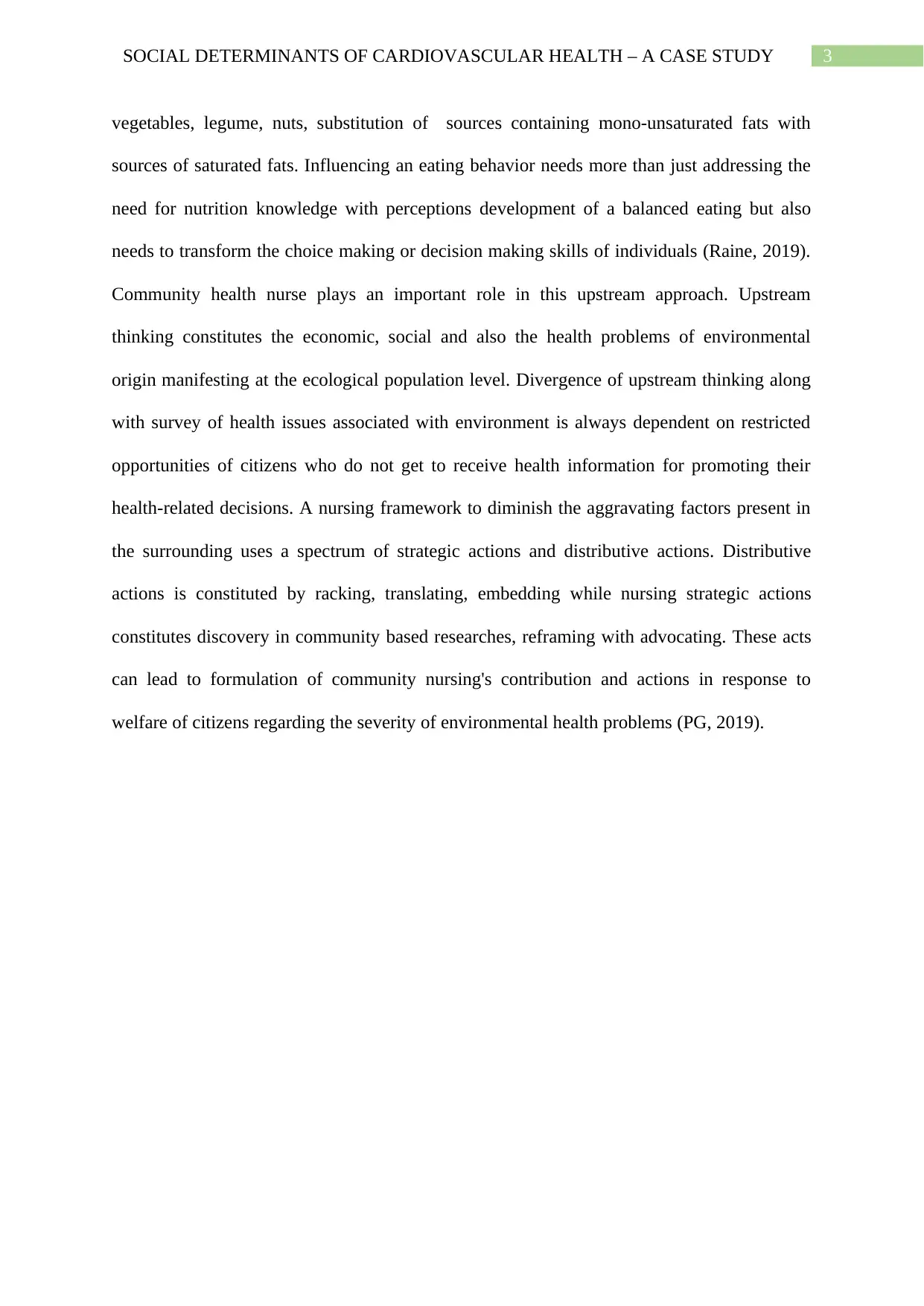
3SOCIAL DETERMINANTS OF CARDIOVASCULAR HEALTH – A CASE STUDY
vegetables, legume, nuts, substitution of sources containing mono-unsaturated fats with
sources of saturated fats. Influencing an eating behavior needs more than just addressing the
need for nutrition knowledge with perceptions development of a balanced eating but also
needs to transform the choice making or decision making skills of individuals (Raine, 2019).
Community health nurse plays an important role in this upstream approach. Upstream
thinking constitutes the economic, social and also the health problems of environmental
origin manifesting at the ecological population level. Divergence of upstream thinking along
with survey of health issues associated with environment is always dependent on restricted
opportunities of citizens who do not get to receive health information for promoting their
health-related decisions. A nursing framework to diminish the aggravating factors present in
the surrounding uses a spectrum of strategic actions and distributive actions. Distributive
actions is constituted by racking, translating, embedding while nursing strategic actions
constitutes discovery in community based researches, reframing with advocating. These acts
can lead to formulation of community nursing's contribution and actions in response to
welfare of citizens regarding the severity of environmental health problems (PG, 2019).
vegetables, legume, nuts, substitution of sources containing mono-unsaturated fats with
sources of saturated fats. Influencing an eating behavior needs more than just addressing the
need for nutrition knowledge with perceptions development of a balanced eating but also
needs to transform the choice making or decision making skills of individuals (Raine, 2019).
Community health nurse plays an important role in this upstream approach. Upstream
thinking constitutes the economic, social and also the health problems of environmental
origin manifesting at the ecological population level. Divergence of upstream thinking along
with survey of health issues associated with environment is always dependent on restricted
opportunities of citizens who do not get to receive health information for promoting their
health-related decisions. A nursing framework to diminish the aggravating factors present in
the surrounding uses a spectrum of strategic actions and distributive actions. Distributive
actions is constituted by racking, translating, embedding while nursing strategic actions
constitutes discovery in community based researches, reframing with advocating. These acts
can lead to formulation of community nursing's contribution and actions in response to
welfare of citizens regarding the severity of environmental health problems (PG, 2019).
Paraphrase This Document
Need a fresh take? Get an instant paraphrase of this document with our AI Paraphraser
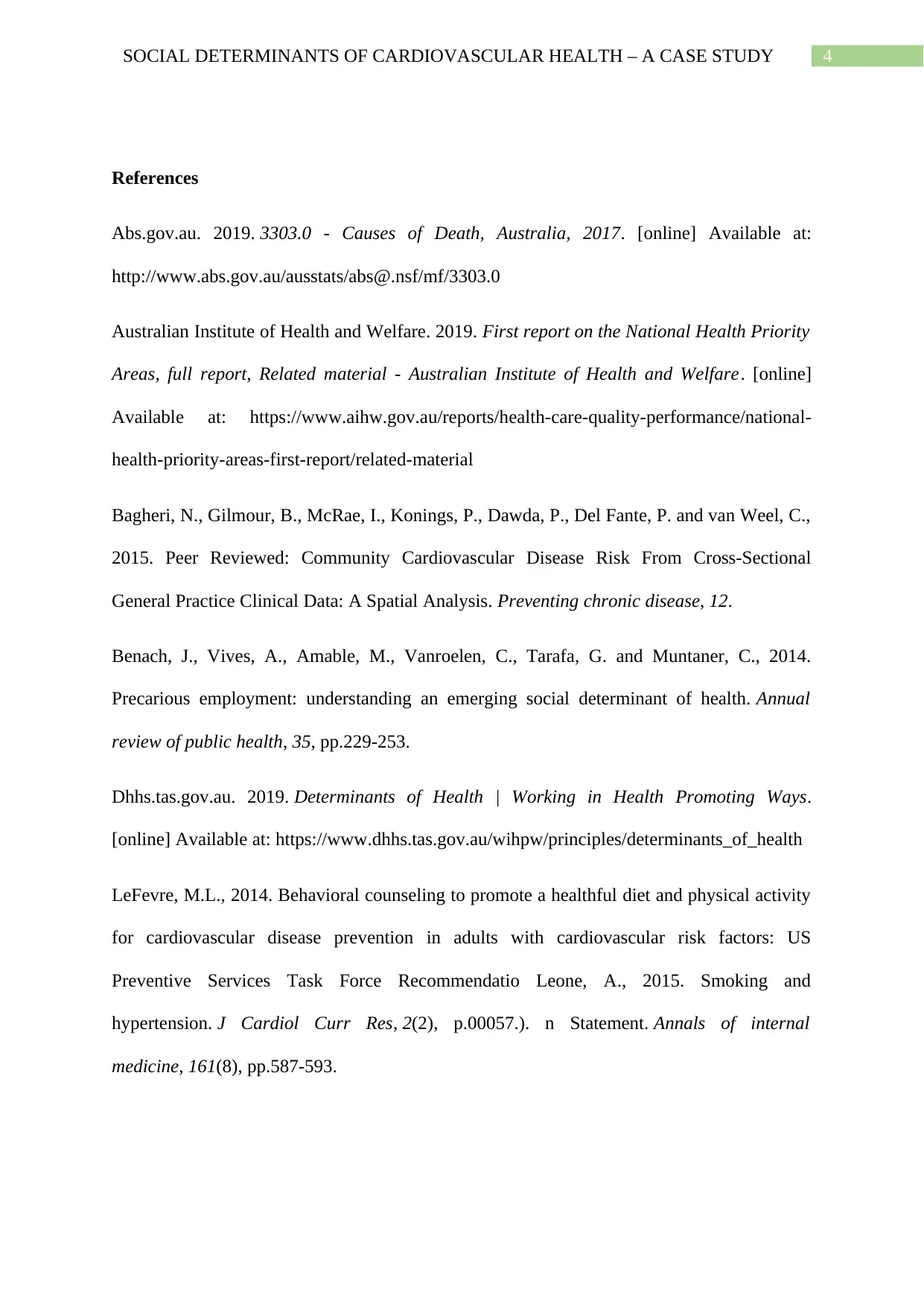
4SOCIAL DETERMINANTS OF CARDIOVASCULAR HEALTH – A CASE STUDY
References
Abs.gov.au. 2019. 3303.0 - Causes of Death, Australia, 2017. [online] Available at:
http://www.abs.gov.au/ausstats/abs@.nsf/mf/3303.0
Australian Institute of Health and Welfare. 2019. First report on the National Health Priority
Areas, full report, Related material - Australian Institute of Health and Welfare. [online]
Available at: https://www.aihw.gov.au/reports/health-care-quality-performance/national-
health-priority-areas-first-report/related-material
Bagheri, N., Gilmour, B., McRae, I., Konings, P., Dawda, P., Del Fante, P. and van Weel, C.,
2015. Peer Reviewed: Community Cardiovascular Disease Risk From Cross-Sectional
General Practice Clinical Data: A Spatial Analysis. Preventing chronic disease, 12.
Benach, J., Vives, A., Amable, M., Vanroelen, C., Tarafa, G. and Muntaner, C., 2014.
Precarious employment: understanding an emerging social determinant of health. Annual
review of public health, 35, pp.229-253.
Dhhs.tas.gov.au. 2019. Determinants of Health | Working in Health Promoting Ways.
[online] Available at: https://www.dhhs.tas.gov.au/wihpw/principles/determinants_of_health
LeFevre, M.L., 2014. Behavioral counseling to promote a healthful diet and physical activity
for cardiovascular disease prevention in adults with cardiovascular risk factors: US
Preventive Services Task Force Recommendatio Leone, A., 2015. Smoking and
hypertension. J Cardiol Curr Res, 2(2), p.00057.). n Statement. Annals of internal
medicine, 161(8), pp.587-593.
References
Abs.gov.au. 2019. 3303.0 - Causes of Death, Australia, 2017. [online] Available at:
http://www.abs.gov.au/ausstats/abs@.nsf/mf/3303.0
Australian Institute of Health and Welfare. 2019. First report on the National Health Priority
Areas, full report, Related material - Australian Institute of Health and Welfare. [online]
Available at: https://www.aihw.gov.au/reports/health-care-quality-performance/national-
health-priority-areas-first-report/related-material
Bagheri, N., Gilmour, B., McRae, I., Konings, P., Dawda, P., Del Fante, P. and van Weel, C.,
2015. Peer Reviewed: Community Cardiovascular Disease Risk From Cross-Sectional
General Practice Clinical Data: A Spatial Analysis. Preventing chronic disease, 12.
Benach, J., Vives, A., Amable, M., Vanroelen, C., Tarafa, G. and Muntaner, C., 2014.
Precarious employment: understanding an emerging social determinant of health. Annual
review of public health, 35, pp.229-253.
Dhhs.tas.gov.au. 2019. Determinants of Health | Working in Health Promoting Ways.
[online] Available at: https://www.dhhs.tas.gov.au/wihpw/principles/determinants_of_health
LeFevre, M.L., 2014. Behavioral counseling to promote a healthful diet and physical activity
for cardiovascular disease prevention in adults with cardiovascular risk factors: US
Preventive Services Task Force Recommendatio Leone, A., 2015. Smoking and
hypertension. J Cardiol Curr Res, 2(2), p.00057.). n Statement. Annals of internal
medicine, 161(8), pp.587-593.
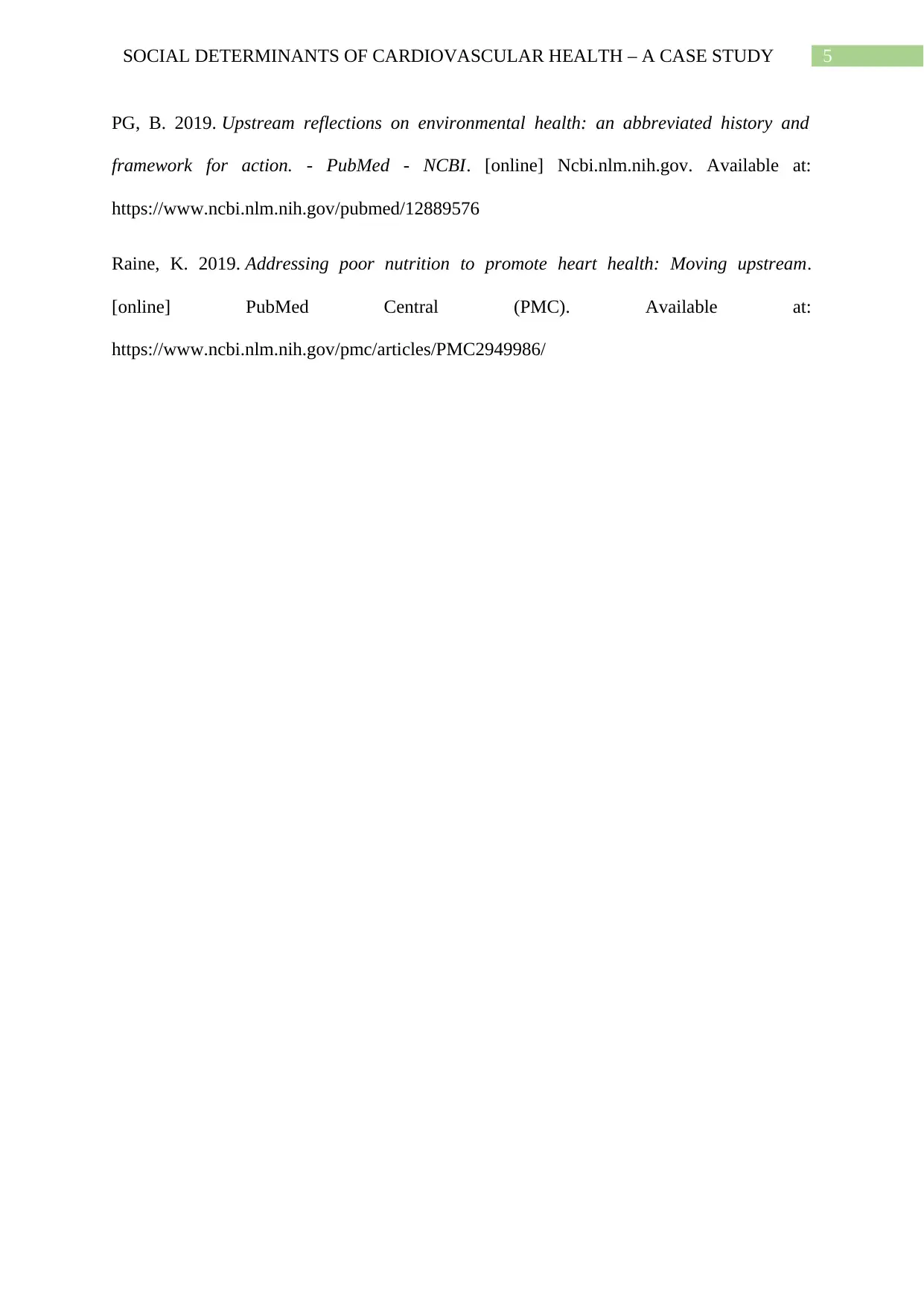
5SOCIAL DETERMINANTS OF CARDIOVASCULAR HEALTH – A CASE STUDY
PG, B. 2019. Upstream reflections on environmental health: an abbreviated history and
framework for action. - PubMed - NCBI. [online] Ncbi.nlm.nih.gov. Available at:
https://www.ncbi.nlm.nih.gov/pubmed/12889576
Raine, K. 2019. Addressing poor nutrition to promote heart health: Moving upstream.
[online] PubMed Central (PMC). Available at:
https://www.ncbi.nlm.nih.gov/pmc/articles/PMC2949986/
PG, B. 2019. Upstream reflections on environmental health: an abbreviated history and
framework for action. - PubMed - NCBI. [online] Ncbi.nlm.nih.gov. Available at:
https://www.ncbi.nlm.nih.gov/pubmed/12889576
Raine, K. 2019. Addressing poor nutrition to promote heart health: Moving upstream.
[online] PubMed Central (PMC). Available at:
https://www.ncbi.nlm.nih.gov/pmc/articles/PMC2949986/
⊘ This is a preview!⊘
Do you want full access?
Subscribe today to unlock all pages.

Trusted by 1+ million students worldwide
1 out of 6
Related Documents
Your All-in-One AI-Powered Toolkit for Academic Success.
+13062052269
info@desklib.com
Available 24*7 on WhatsApp / Email
![[object Object]](/_next/static/media/star-bottom.7253800d.svg)
Unlock your academic potential
Copyright © 2020–2025 A2Z Services. All Rights Reserved. Developed and managed by ZUCOL.





